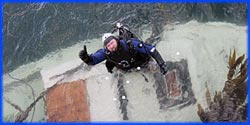


Premier Date: October 28, 2009
busted
Adam and Jamie started stove fires with three different cooking materials: canola oil, peanut oil, and lard. The ratio of oil to water was 8 to 1 in each case, with 64 US fluid ounces (1,900 mL) of oil and 8 US fluid ounces (240 mL) of water. In each case, a large fireball formed when the water was poured in, due to the sudden formation of steam which propelled the burning oil upward. No fireball reached higher than 25 feet (7.6 m). To investigate further, Adam and Jamie did some smaller-scale tests, varying the oil/water ratio and the shape of the cooking pot. The latter had no apparent effect on the fireball height, but they decided to use a 2:1 ratio (2 US qt/1,900 mL of oil, 1 US qt/950 mL of water) for further full-scale work in a mockup kitchen set. Under these conditions, they were able to get a 30-foot (9.1 m) fireball; however, they declared the myth busted because the original 8:1 ratio did not generate the stated result. In a further test, they set up a shelf to drop an unopened can of soup into the oil, reasoning that having all the water-based material at the bottom of the pot would more effectively launch the oil when it vaporized and exploded. The result was a fireball with an estimated height of 100 feet (30 m).
confirmed
Adam called in a firefighting helicopter, which dropped 500 US gallons (1,900 L) of water on the grease fire and successfully extinguished it.
busted
The Build Team set up three microwave ovens, each of which contained a different C-4 device: one unaltered block, one with wiring similar to that used in the film, and one with both wiring and a blasting cap. Using a remote-controlled bomb disposal robot, the team set each oven to run for 60 seconds at full power. The unaltered block did not heat up appreciably, while the one with only the wiring caught fire but did not detonate (though the door of that oven did burst open). The wiring/cap device exploded violently after only a few seconds of heating, due to sparks arcing across the metal wires and touching off the blasting cap. Since a person placing this bomb in a microwave would be unable to get to safety before it exploded, the team declared the myth busted.
(This myth is based on a scene from the film Grosse Pointe Blank.)
confirmed
The Build Team evaluated three different cheeses for hardness, stiffness, and elasticity: Edam, smoked Gouda, and Garrotxa. They set up a canvas sail made with period-accurate materials and methods, and fired one sample of each cheese at it. Edam, the softest of the three, bounced off the sail without damaging it; Gouda, the hardest, was too brittle and broke up into fragments as soon as it left the barrel; but the Garrotxa, having the right mix of hardness and elasticity, remained intact and punched a hole in the canvas. Even though the exact type of cheese did not match the accounts, the team declared the myth confirmed.
(This myth is based on accounts of a 19th-century South American naval battle in which a Uruguayan commander was forced to use slabs of Dutch Edam instead of cannonballs when the ammunition ran out.)
Previous: Episode 127: Dirty vs. Clean Car